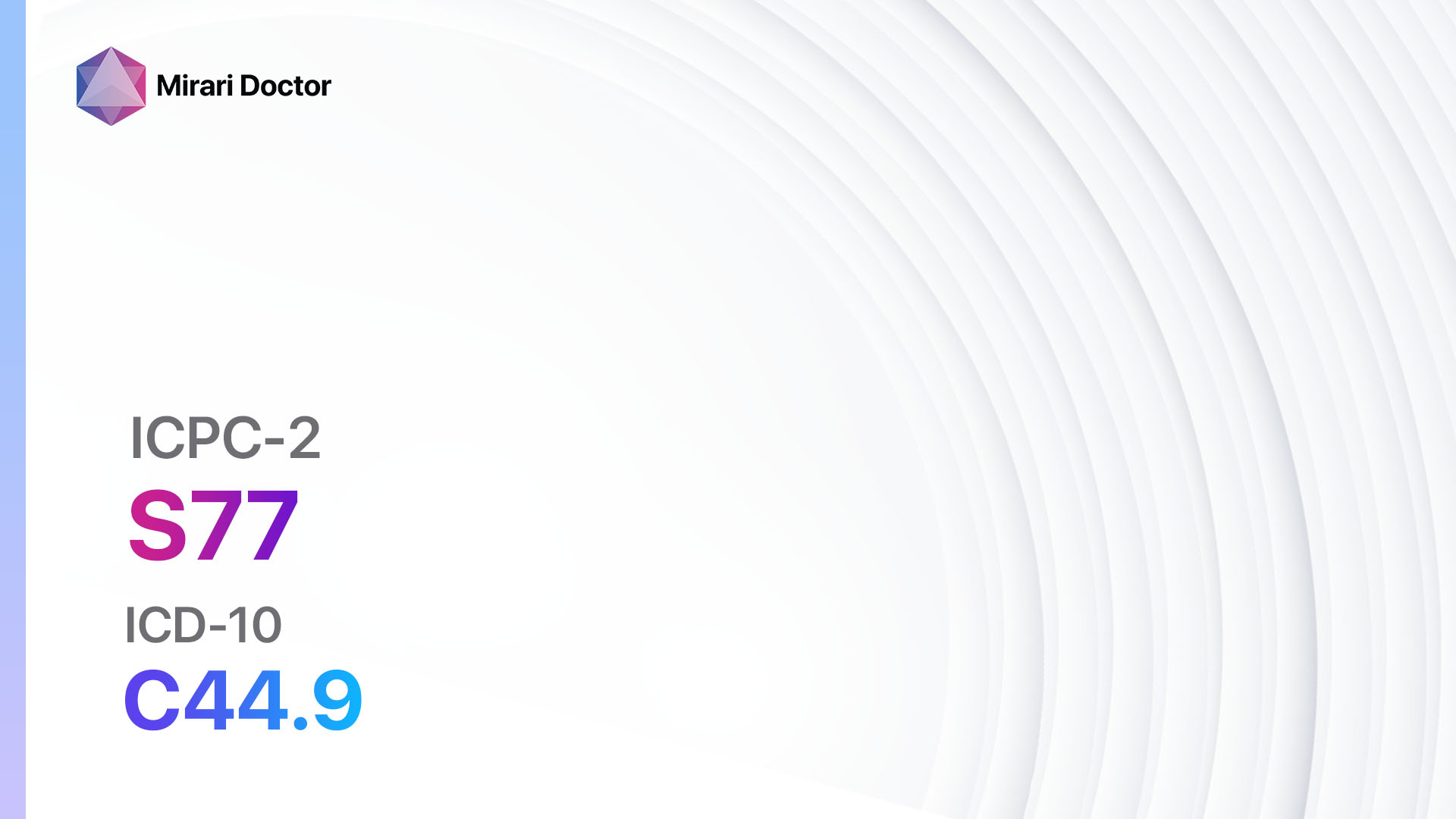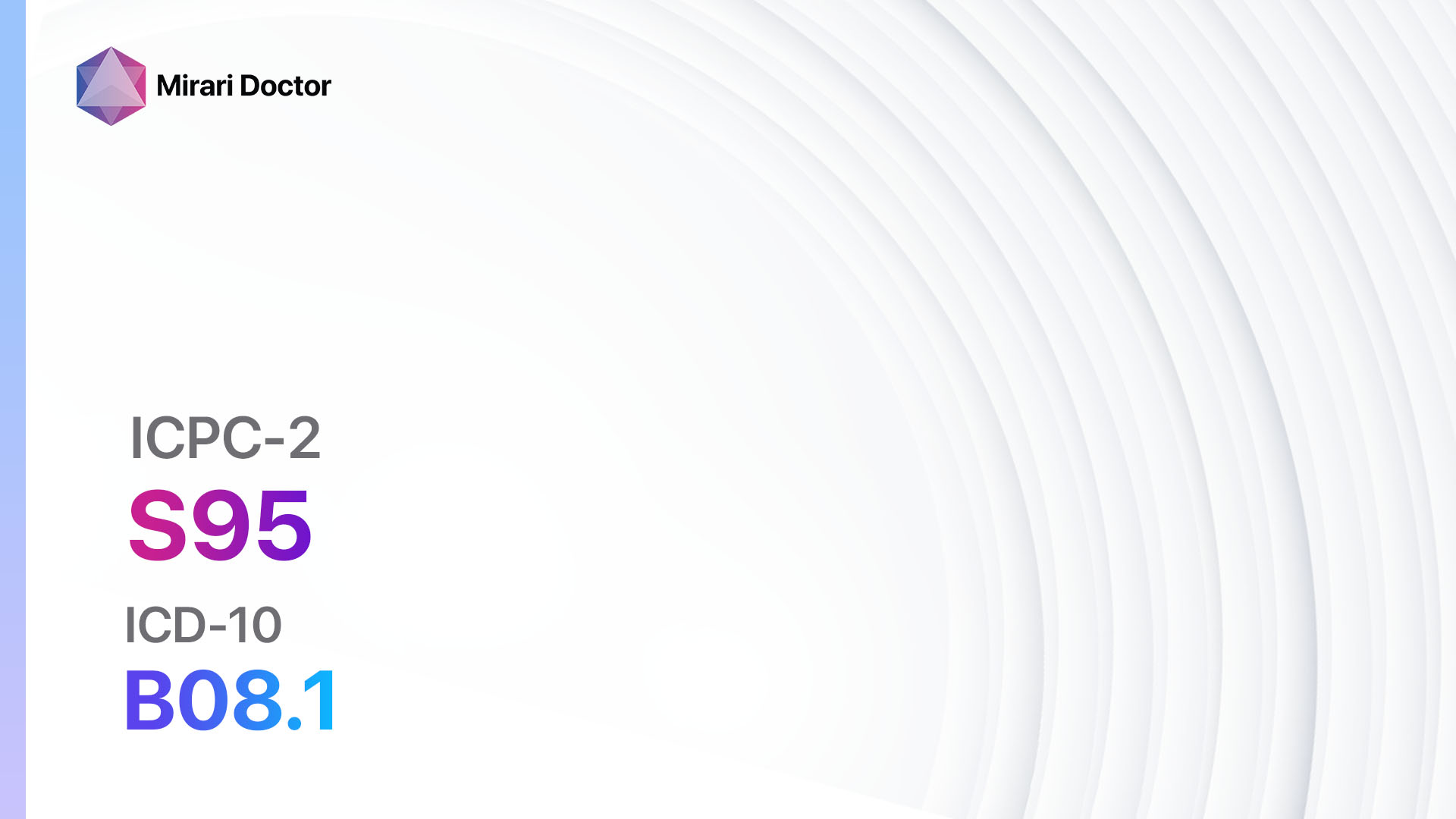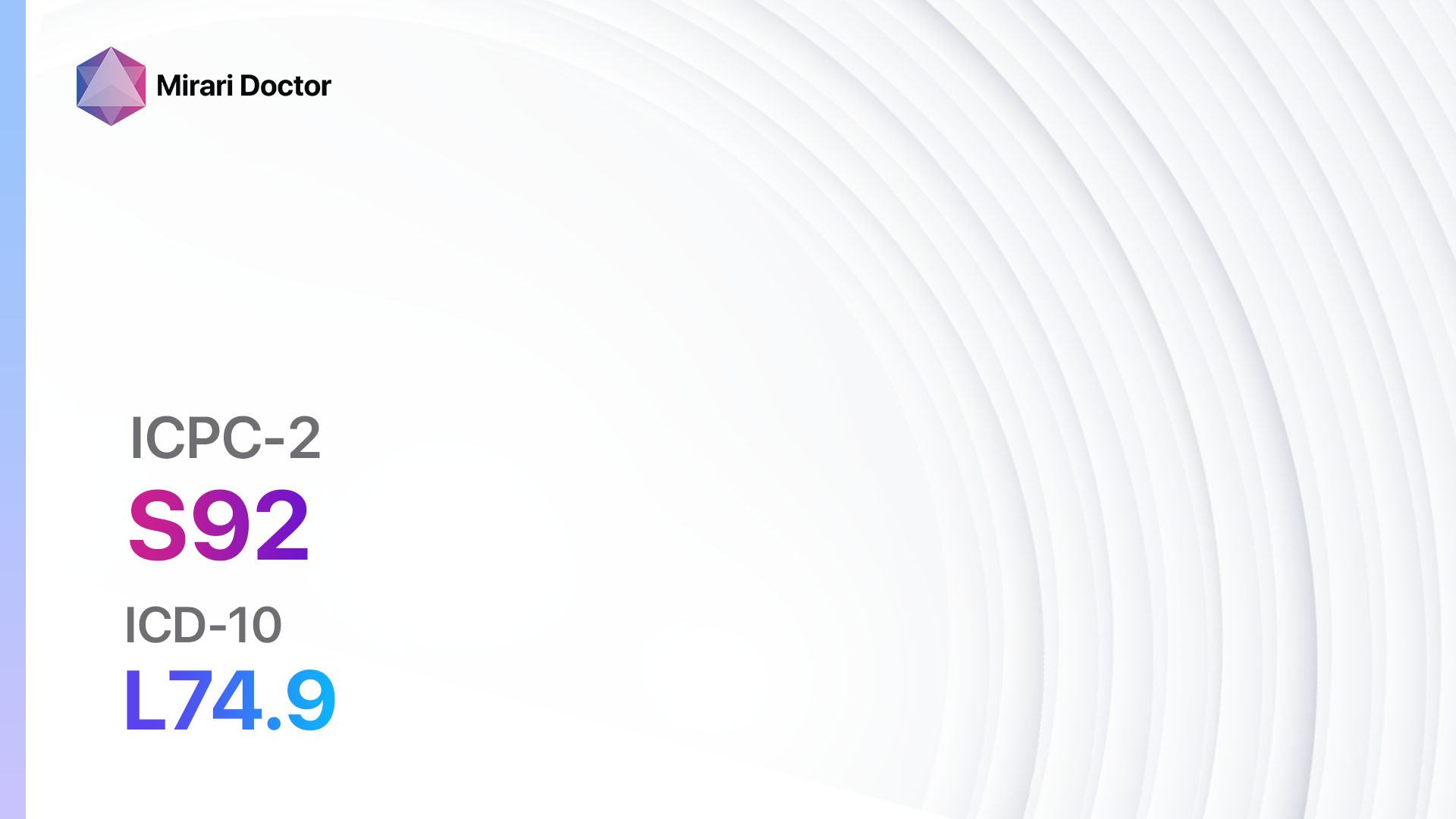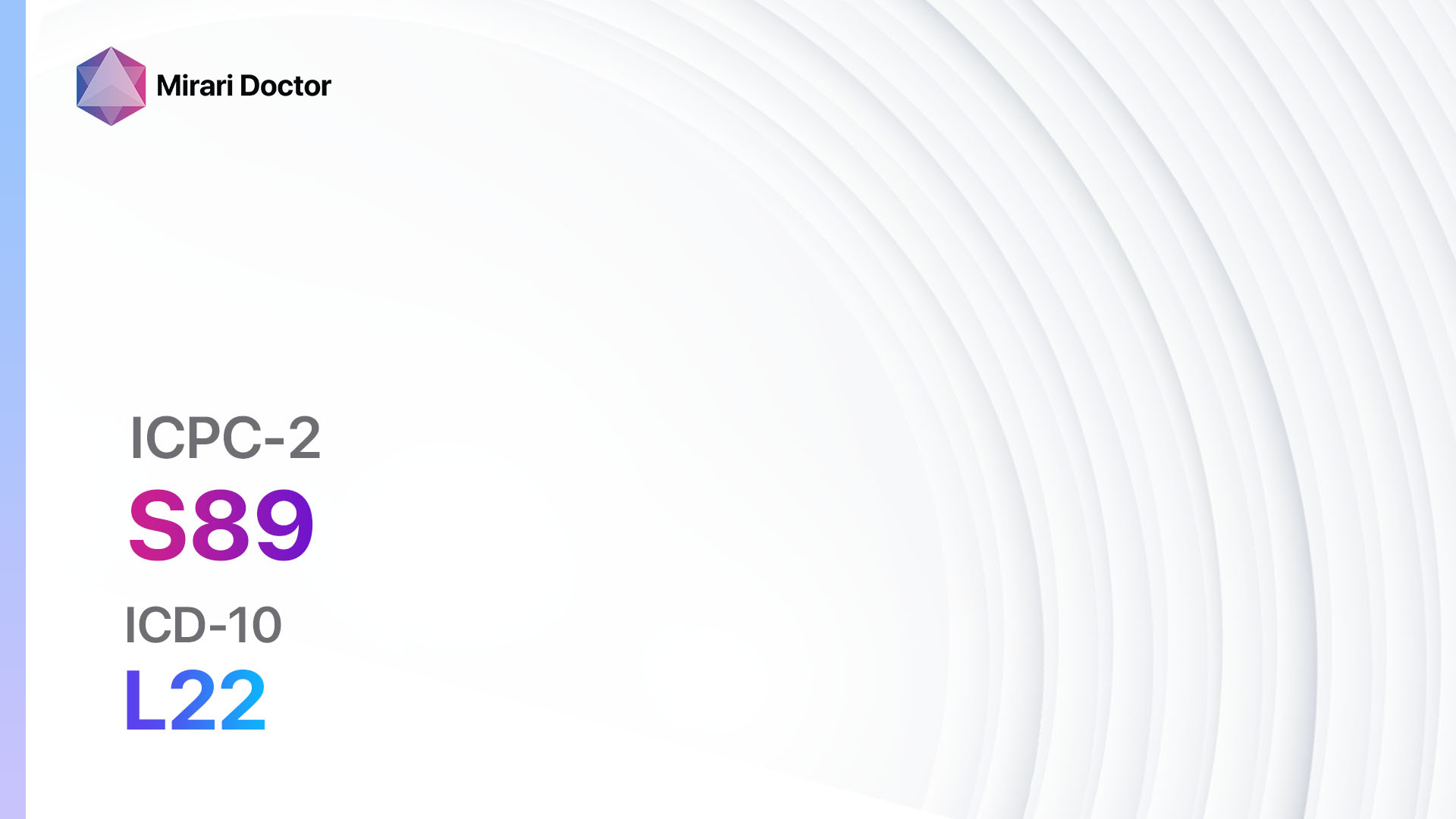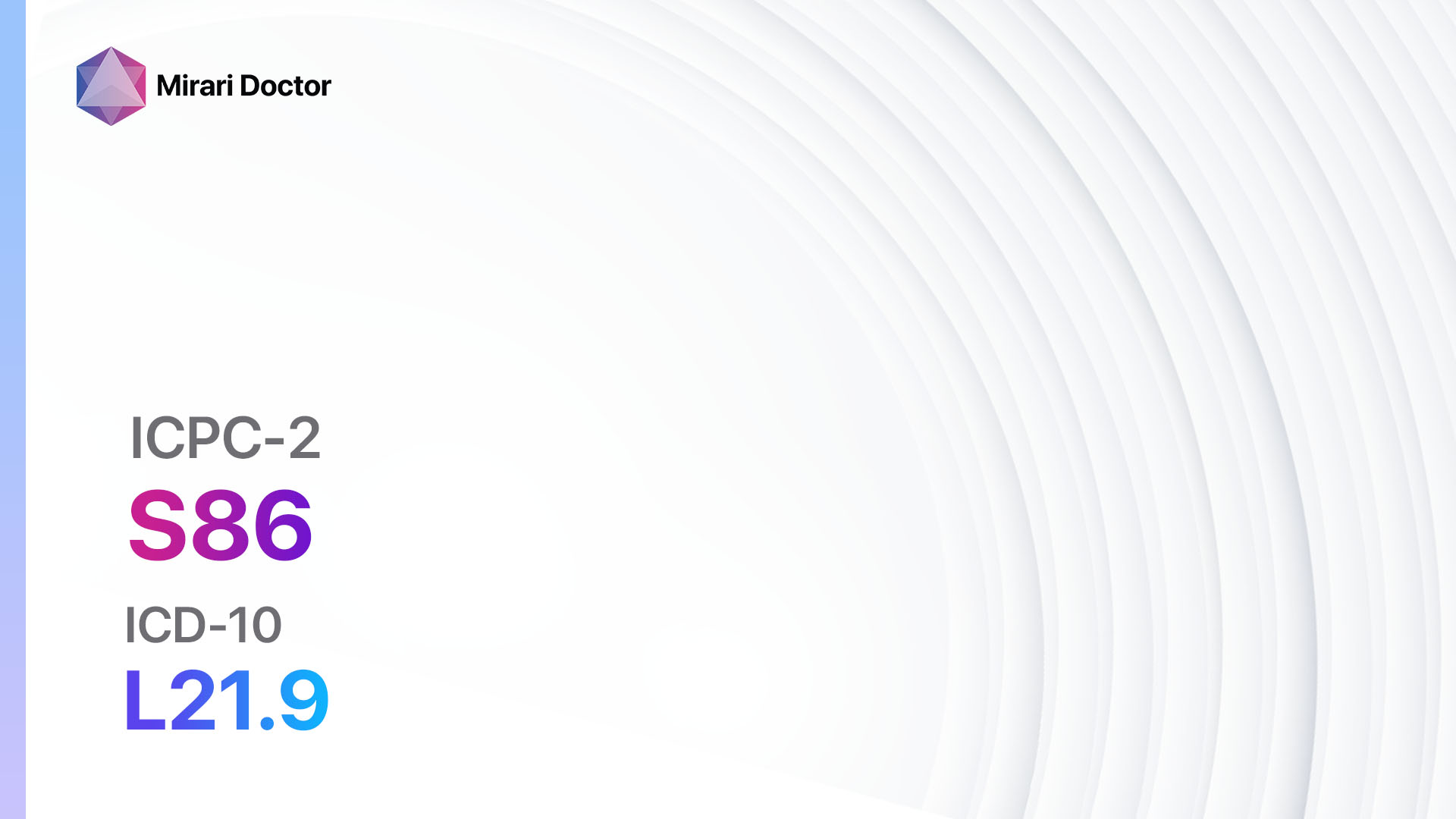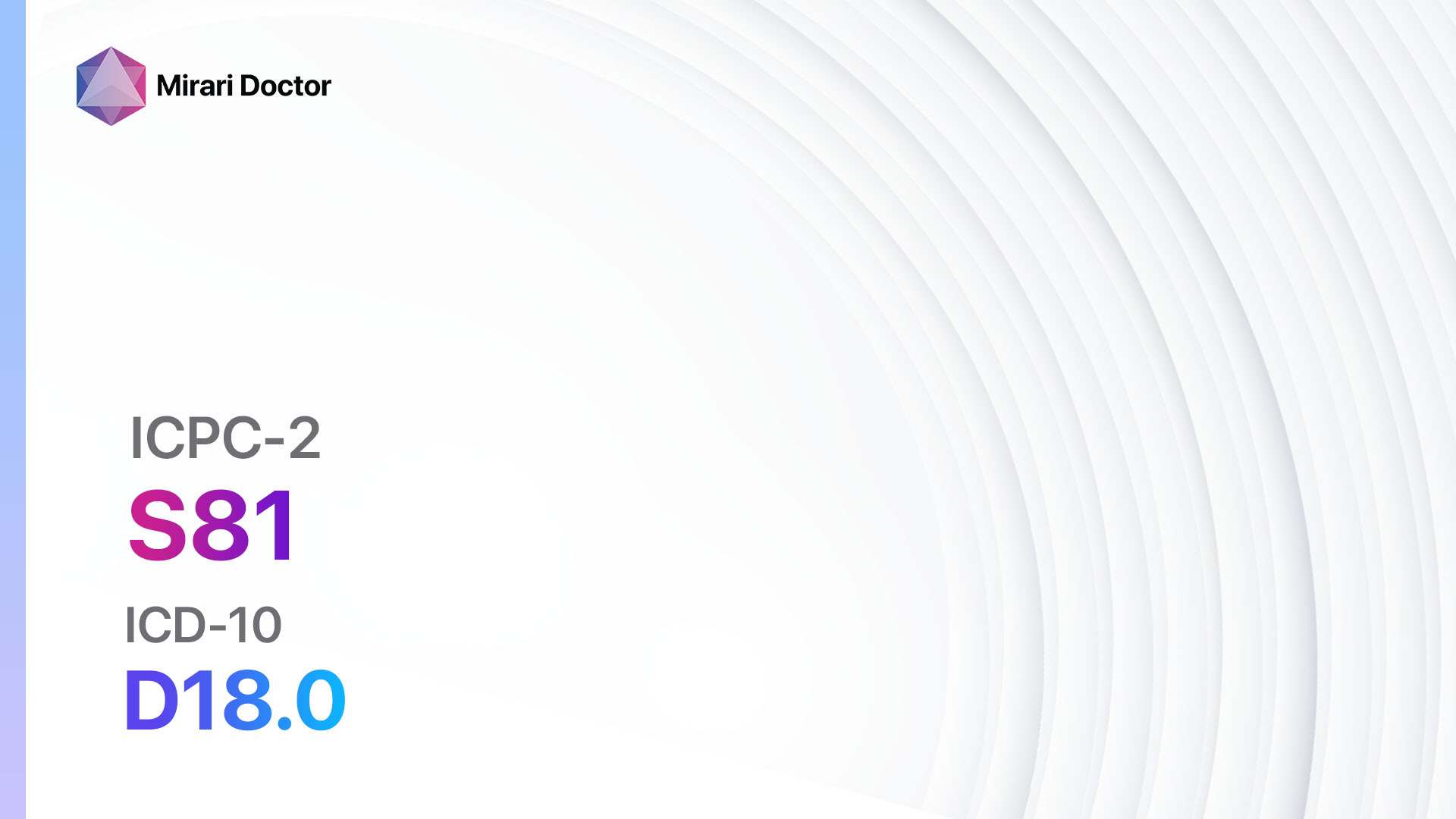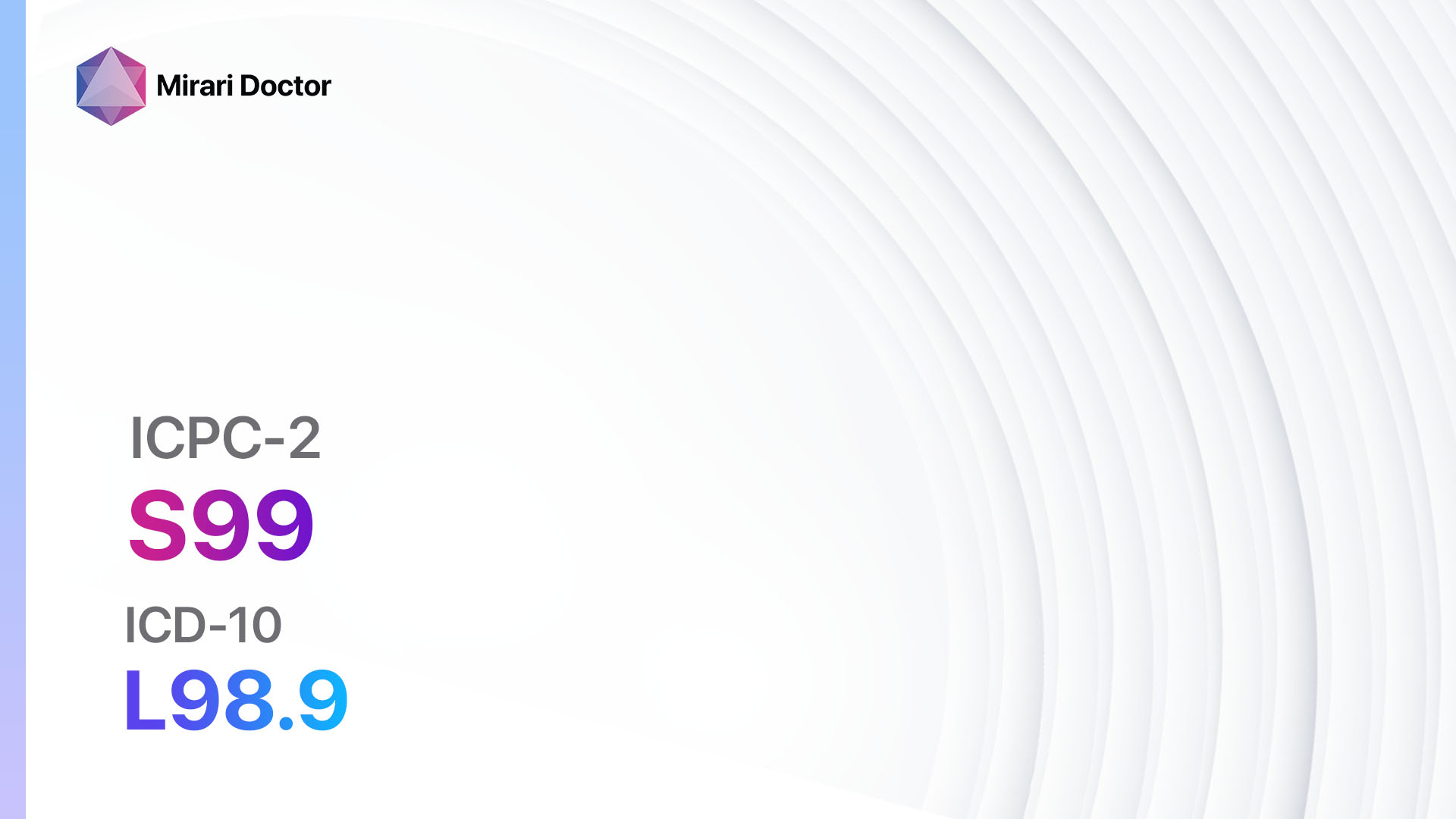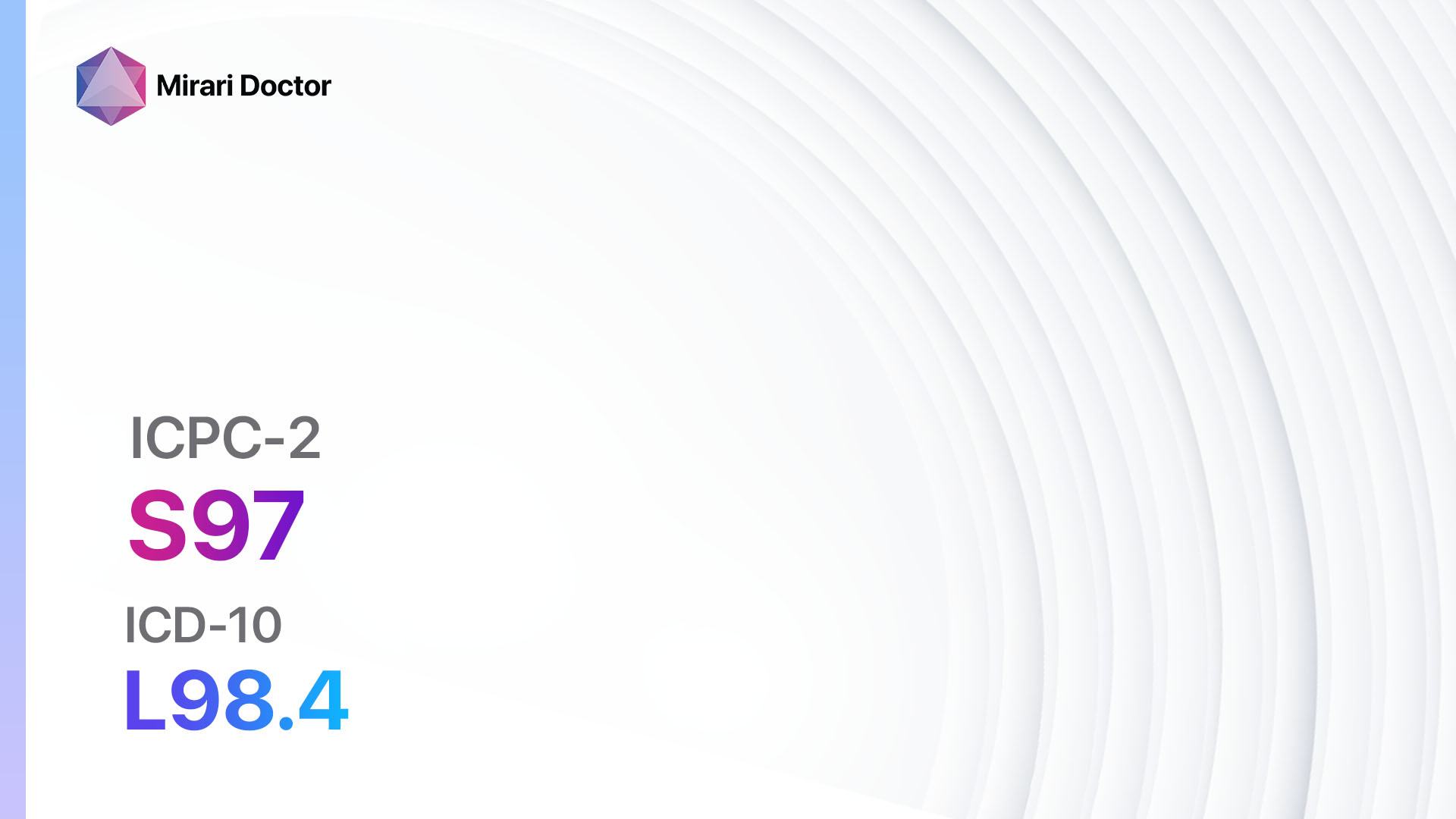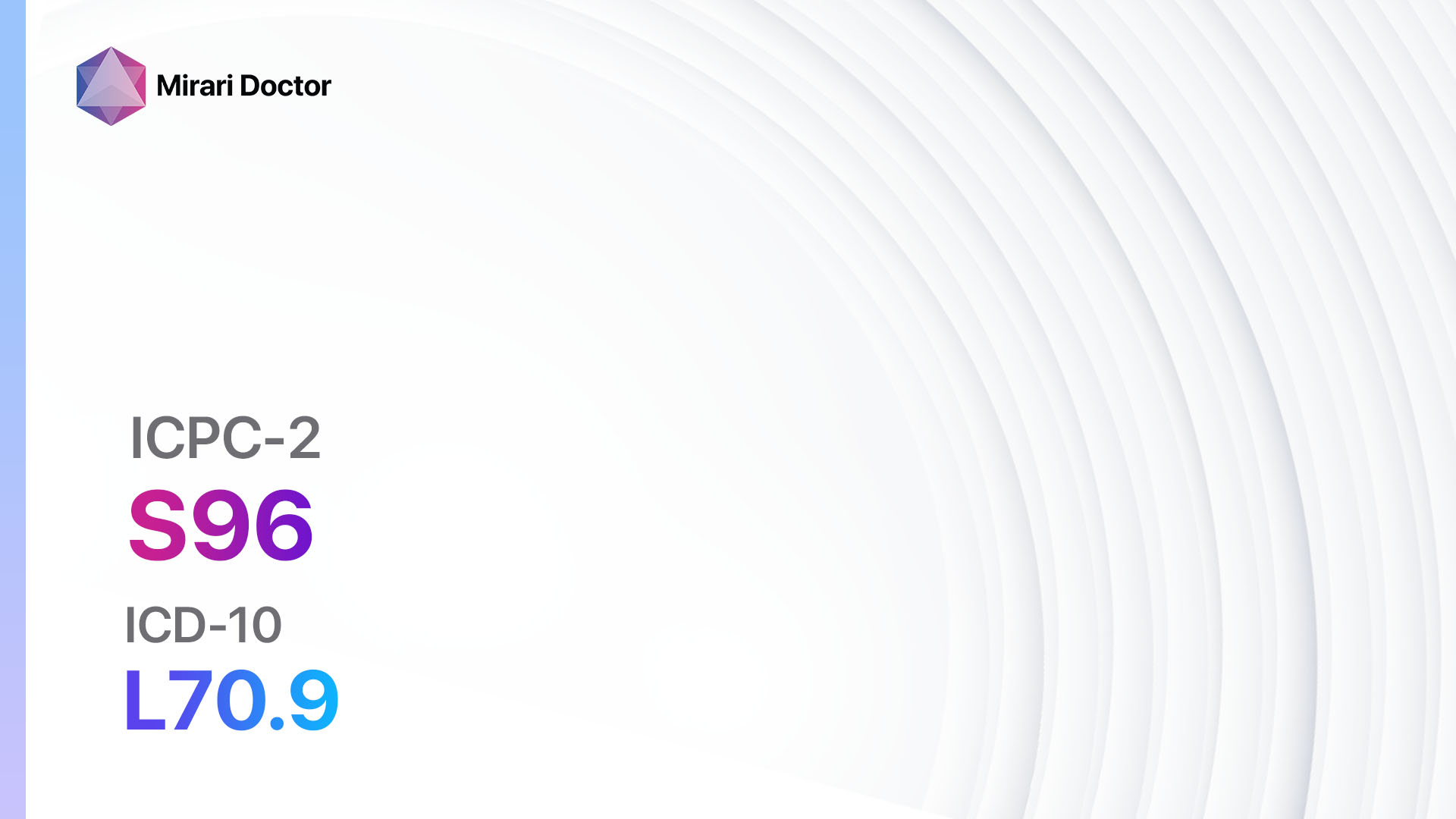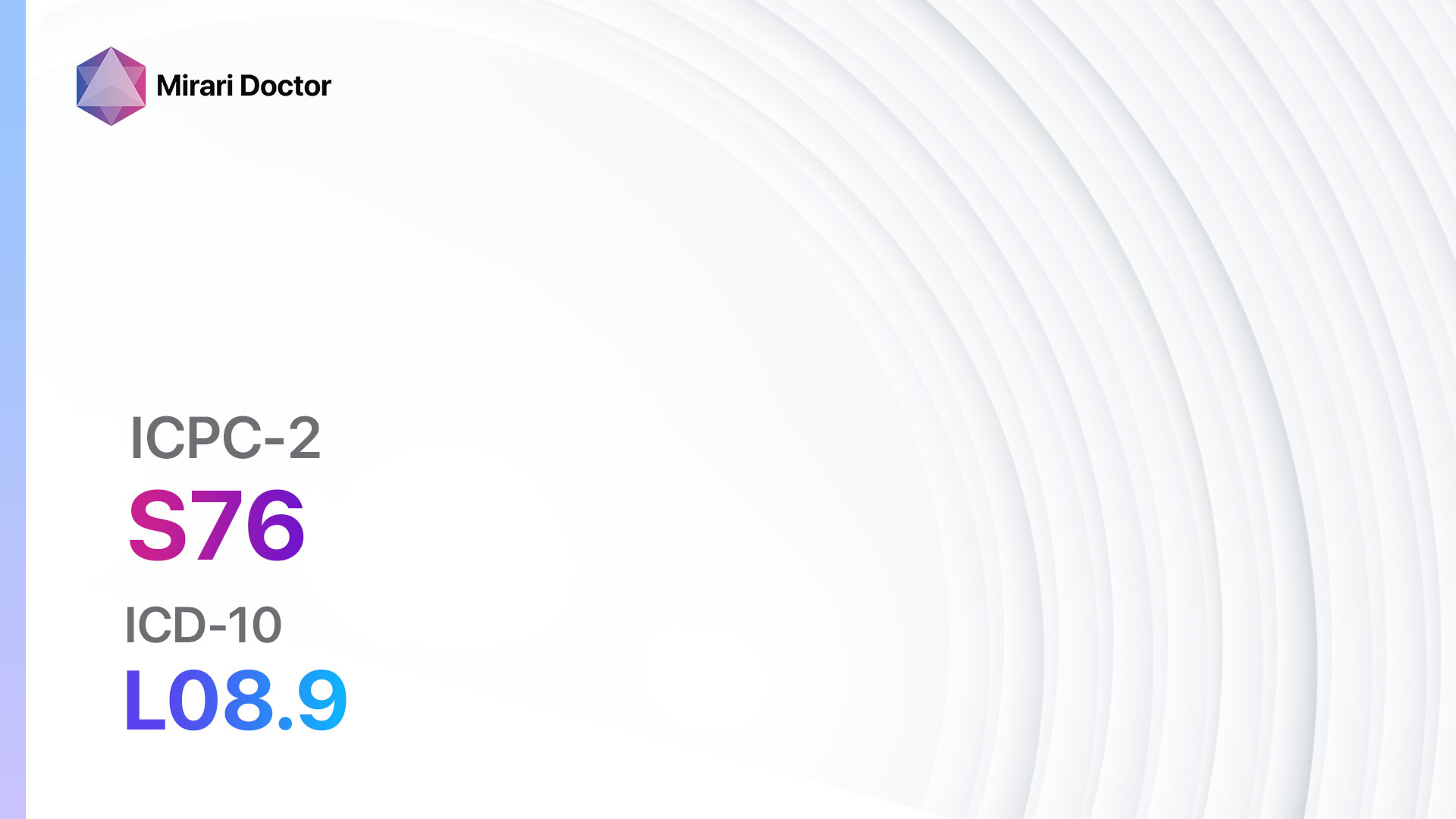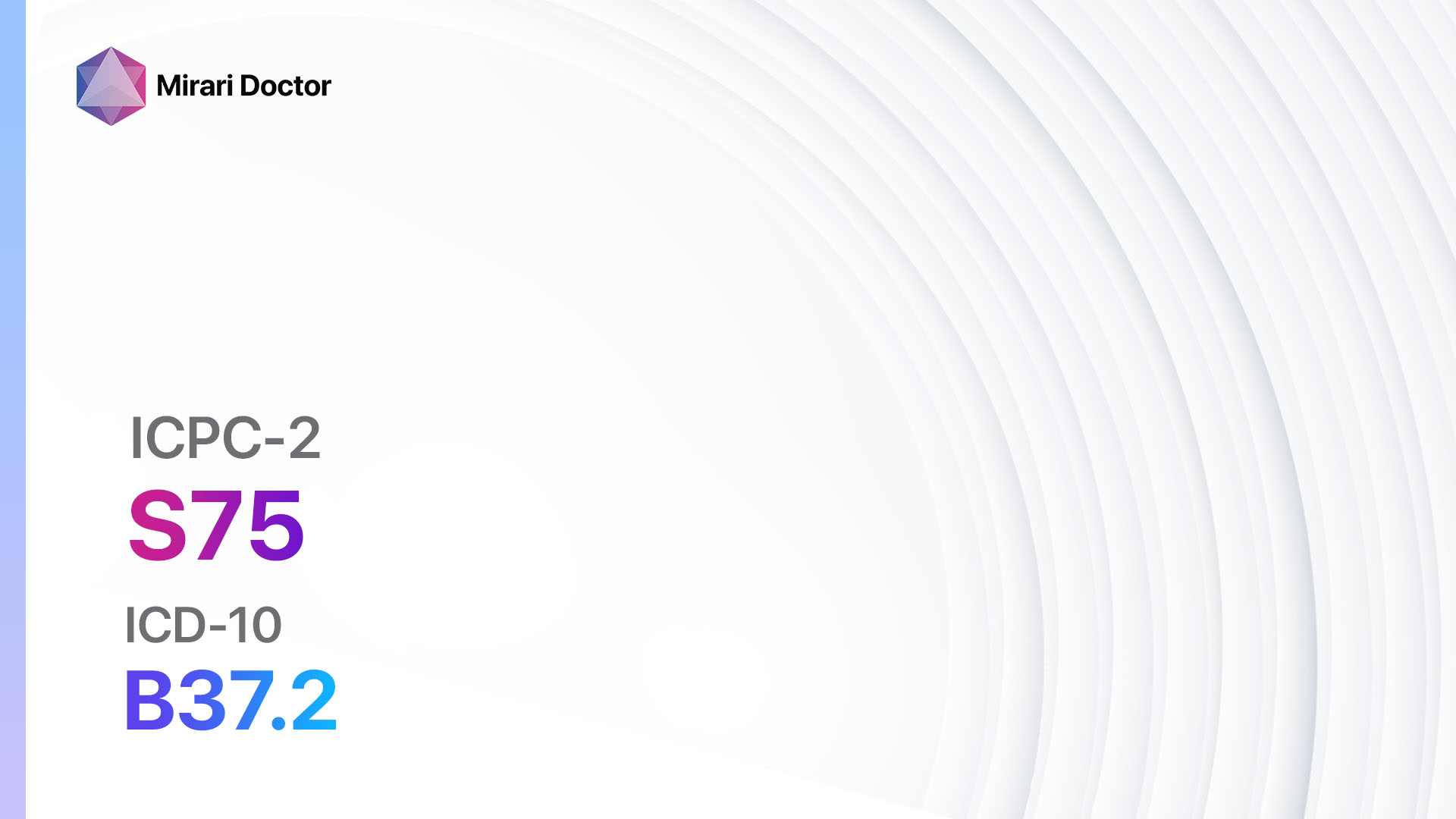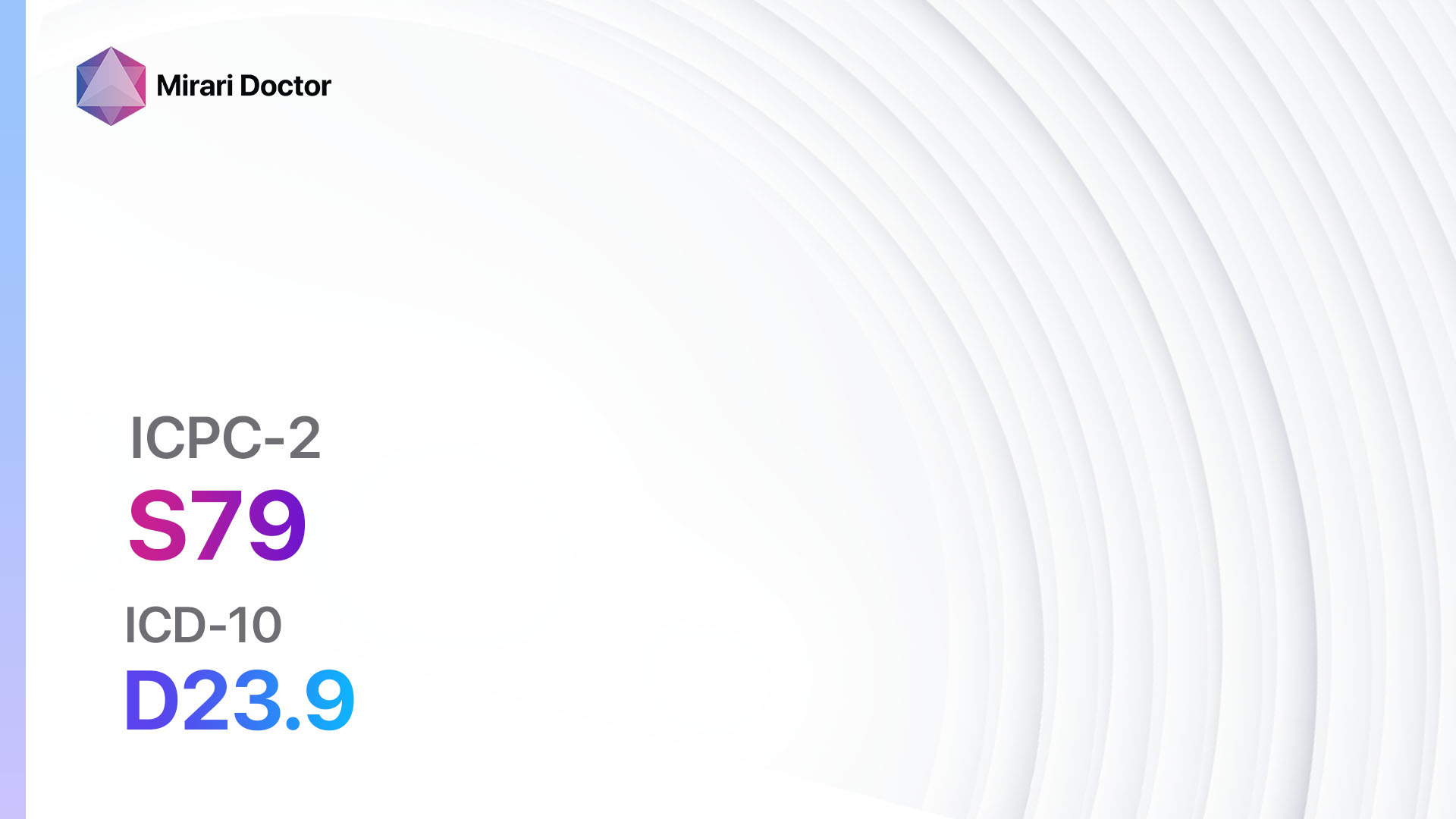
Introduction
Neoplasm skin benign/unspecified refers to the development of non-cancerous growths on the skin. These growths are typically harmless and do not spread to other parts of the body[1]. The aim of this guide is to provide a comprehensive overview of the diagnostic steps and possible interventions for neoplasm skin benign/unspecified.
Codes
- ICPC-2 Code: S79 Neoplasm skin benign/unspecified[2]
- ICD-10 Code: D23.9 Other benign neoplasms of skin, unspecified[3]
Symptoms
- Appearance of a new growth on the skin
- Changes in the size, shape, or color of an existing mole or growth
- Itching or bleeding from the growth
- Pain or tenderness in the area of the growth[4]
Causes
- Excessive exposure to ultraviolet (UV) radiation from the sun or tanning beds
- Genetic factors
- Age-related changes in the skin
- Weakened immune system[5]
Diagnostic Steps
Medical History
- Gather information about the patient’s risk factors, such as a history of excessive sun exposure or family history of skin cancer
- Inquire about any medical conditions or medications that may weaken the immune system
- Ask about the duration and progression of the skin growths
- Assess any symptoms associated with the growths, such as itching or bleeding[6]
Physical Examination
- Perform a thorough examination of the skin, paying close attention to the location, size, shape, and color of the growths
- Palpate the growths to assess for tenderness or other abnormalities
- Check for any signs of inflammation or infection in the surrounding skin[7]
Determine Severity
- Classify the neoplasm skin benign/unspecified based on severity and depth, if applicable
- Superficial neoplasms are limited to the outermost layer of the skin, while deep neoplasms penetrate deeper layers
- Assess the size and extent of the growths to determine the severity[8]
Laboratory Tests
- No specific laboratory tests are typically required for the diagnosis of neoplasm skin benign/unspecified
- However, a skin biopsy may be performed to confirm the diagnosis and rule out other conditions[9]
Diagnostic Imaging
- No diagnostic imaging is necessary for the diagnosis of neoplasm skin benign/unspecified[10]
Other Tests
- No other diagnostic tests are typically necessary for the diagnosis of neoplasm skin benign/unspecified
Follow-up and Patient Education
- Schedule regular follow-up appointments to monitor the growths and assess for any changes
- Educate the patient about the importance of sun protection and self-examination of the skin
- Provide information about the signs and symptoms of skin cancer and when to seek medical attention
Possible Interventions
Traditional Interventions
Medications:
Top 5 drugs for neoplasm skin benign/unspecified:
- Topical corticosteroids (e.g., hydrocortisone):
- Cost: $5-$20 per tube
- Contraindications: Hypersensitivity to corticosteroids
- Side effects: Skin thinning, irritation
- Severe side effects: None reported
- Drug interactions: None reported
- Warning: Prolonged use may lead to skin atrophy
- Imiquimod (e.g., Aldara):
- Cost: $200-$400 per box
- Contraindications: Hypersensitivity to imiquimod
- Side effects: Local skin reactions, flu-like symptoms
- Severe side effects: None reported
- Drug interactions: None reported
- Warning: Avoid contact with eyes, lips, and nostrils
- Cryotherapy (liquid nitrogen):
- Cost: $100-$300 per session
- Contraindications: None reported
- Side effects: Pain, blistering, scarring
- Severe side effects: None reported
- Drug interactions: None reported
- Warning: Multiple sessions may be required for complete removal
- Electrosurgery (electrocautery):
- Cost: $200-$500 per session
- Contraindications: None reported
- Side effects: Pain, scarring
- Severe side effects: None reported
- Drug interactions: None reported
- Warning: Local anesthesia may be required
- Surgical excision:
- Cost: $500-$2000 per procedure
- Contraindications: None reported
- Side effects: Pain, scarring
- Severe side effects: None reported
- Drug interactions: None reported
- Warning: Local or general anesthesia may be required
Alternative Drugs:
- Salicylic acid: Used for the treatment of warts and other benign skin growths. Cost: $10-$20 per bottle.
- Podophyllin: A resin that can be applied topically to treat certain types of skin growths. Cost: $50-$100 per bottle.
- Cantharidin: A blistering agent that is applied topically to remove warts and other growths. Cost: $50-$100 per vial.
- 5-fluorouracil (5-FU): A chemotherapy medication that can be used topically to treat certain types of skin growths. Cost: $100-$200 per tube.
- Laser therapy: Uses focused laser beams to destroy or remove skin growths. Cost: $200-$500 per session.
Surgical Procedures:
- Excisional biopsy: Surgical removal of the entire growth for further examination. Cost: $500-$2000 per procedure.
- Mohs surgery: A specialized surgical technique that involves removing thin layers of skin until no abnormal cells remain. Cost: $1000-$5000 per procedure.
Alternative Interventions
- Cryotherapy: Freezing the growths with liquid nitrogen to destroy the abnormal cells. Cost: $100-$300 per session.
- Electrosurgery: Using an electric current to burn and remove the growths. Cost: $200-$500 per session.
- Laser therapy: Using laser beams to destroy or remove the growths. Cost: $200-$500 per session.
- Herbal remedies: Some herbal remedies, such as aloe vera or tea tree oil, may have potential benefits for treating skin growths. Cost: Varies depending on the specific remedy.
Lifestyle Interventions
- Sun protection: Encourage the use of sunscreen, protective clothing, and hats to minimize sun exposure. Cost: $10-$30 per bottle of sunscreen.
- Healthy diet: Promote a diet rich in fruits, vegetables, and antioxidants to support overall skin health. Cost: Varies depending on individual food choices.
- Smoking cessation: Advise patients to quit smoking, as smoking can worsen skin conditions. Cost: Varies depending on the method used for smoking cessation.
- Stress management: Encourage stress-reducing techniques, such as exercise, meditation, or counseling. Cost: Varies depending on the chosen method of stress management.
It is important to note that the cost ranges provided are approximate and may vary depending on the location and availability of the interventions.
Mirari Cold Plasma Alternative Intervention
Understanding Mirari Cold Plasma
- Safe and Non-Invasive Treatment: Mirari Cold Plasma is a safe and non-invasive treatment option for various skin conditions. It does not require incisions, minimizing the risk of scarring, bleeding, or tissue damage.
- Efficient Extraction of Foreign Bodies: Mirari Cold Plasma facilitates the removal of foreign bodies from the skin by degrading and dissociating organic matter, allowing easier access and extraction.
- Pain Reduction and Comfort: Mirari Cold Plasma has a local analgesic effect, providing pain relief during the treatment, making it more comfortable for the patient.
- Reduced Risk of Infection: Mirari Cold Plasma has antimicrobial properties, effectively killing bacteria and reducing the risk of infection.
- Accelerated Healing and Minimal Scarring: Mirari Cold Plasma stimulates wound healing and tissue regeneration, reducing healing time and minimizing the formation of scars.
Mirari Cold Plasma Prescription
Video instructions for using Mirari Cold Plasma Device – S79 Neoplasm skin benign/unspecified (ICD-10:D23.9)
| Mild | Moderate | Severe |
| Mode setting: 1 (Infection) Location: 0 (Localized) Morning: 15 minutes, Evening: 15 minutes |
Mode setting: 1 (Infection) Location: 0 (Localized) Morning: 30 minutes, Lunch: 30 minutes, Evening: 30 minutes |
Mode setting: 1 (Infection) Location: 0 (Localized) Morning: 30 minutes, Lunch: 30 minutes, Evening: 30 minutes |
| Mode setting: 2 (Wound Healing) Location: 0 (Localized) Morning: 15 minutes, Evening: 15 minutes |
Mode setting: 2 (Wound Healing) Location: 0 (Localized) Morning: 30 minutes, Lunch: 30 minutes, Evening: 30 minutes |
Mode setting: 2 (Wound Healing) Location: 0 (Localized) Morning: 30 minutes, Lunch: 30 minutes, Evening: 30 minutes |
| Mode setting: 10 (Dermatitis/Fungus) Location: 0 (Localized) Morning: 15 minutes, Evening: 15 minutes |
Mode setting: 10 (Dermatitis/Fungus) Location: 0 (Localized) Morning: 30 minutes, Lunch: 30 minutes, Evening: 30 minutes |
Mode setting: 10 (Dermatitis/Fungus) Location: 0 (Localized) Morning: 30 minutes, Lunch: 30 minutes, Evening: 30 minutes |
| Mode setting: 7 (Immunotherapy) Location: 1 (Sacrum) Morning: 15 minutes, Evening: 15 minutes |
Mode setting: 7 (Immunotherapy) Location: 1 (Sacrum) Morning: 15 minutes, Evening: 15 minutes |
Mode setting: 7 (Immunotherapy) Location: 1 (Sacrum) Morning: 15 minutes, Evening: 15 minutes |
| Total Morning: 60 minutes approx. $10 USD, Evening: 60 minutes approx. $10 USD |
Total Morning: 120 minutes approx. $20 USD, Lunch: 120 minutes approx. $20 USD, Evening: 120 minutes approx. $20 USD, |
Total Morning: 120 minutes approx. $20 USD, Lunch: 120 minutes approx. $20 USD, Evening: 120 minutes approx. $20 USD, |
| Usual treatment for 7-60 days approx. $140 USD – $1200 USD | Usual treatment for 6-8 weeks approx. $2,520 USD – $3,360 USD |
Usual treatment for 3-6 months approx. $5,400 USD – $10,800 USD
|
 |
|
Use the Mirari Cold Plasma device to treat Neoplasm skin benign/unspecified effectively.
WARNING: MIRARI COLD PLASMA IS DESIGNED FOR THE HUMAN BODY WITHOUT ANY ARTIFICIAL OR THIRD PARTY PRODUCTS. USE OF OTHER PRODUCTS IN COMBINATION WITH MIRARI COLD PLASMA MAY CAUSE UNPREDICTABLE EFFECTS, HARM OR INJURY. PLEASE CONSULT A MEDICAL PROFESSIONAL BEFORE COMBINING ANY OTHER PRODUCTS WITH USE OF MIRARI.
Step 1: Cleanse the Skin
- Start by cleaning the affected area of the skin with a gentle cleanser or mild soap and water. Gently pat the area dry with a clean towel.
Step 2: Prepare the Mirari Cold Plasma device
- Ensure that the Mirari Cold Plasma device is fully charged or has fresh batteries as per the manufacturer’s instructions. Make sure the device is clean and in good working condition.
- Switch on the Mirari device using the power button or by following the specific instructions provided with the device.
- Some Mirari devices may have adjustable settings for intensity or treatment duration. Follow the manufacturer’s instructions to select the appropriate settings based on your needs and the recommended guidelines.
Step 3: Apply the Device
- Place the Mirari device in direct contact with the affected area of the skin. Gently glide or hold the device over the skin surface, ensuring even coverage of the area experiencing.
- Slowly move the Mirari device in a circular motion or follow a specific pattern as indicated in the user manual. This helps ensure thorough treatment coverage.
Step 4: Monitor and Assess:
- Keep track of your progress and evaluate the effectiveness of the Mirari device in managing your Neoplasm skin benign/unspecified. If you have any concerns or notice any adverse reactions, consult with your health care professional.
Note
This guide is for informational purposes only and should not replace the advice of a medical professional. Always consult with your healthcare provider or a qualified medical professional for personal advice, diagnosis, or treatment. Do not solely rely on the information presented here for decisions about your health. Use of this information is at your own risk. The authors of this guide, nor any associated entities or platforms, are not responsible for any potential adverse effects or outcomes based on the content.
Mirari Cold Plasma System Disclaimer
- Purpose: The Mirari Cold Plasma System is a Class 2 medical device designed for use by trained healthcare professionals. It is registered for use in Thailand and Vietnam. It is not intended for use outside of these locations.
- Informational Use: The content and information provided with the device are for educational and informational purposes only. They are not a substitute for professional medical advice or care.
- Variable Outcomes: While the device is approved for specific uses, individual outcomes can differ. We do not assert or guarantee specific medical outcomes.
- Consultation: Prior to utilizing the device or making decisions based on its content, it is essential to consult with a Certified Mirari Tele-Therapist and your medical healthcare provider regarding specific protocols.
- Liability: By using this device, users are acknowledging and accepting all potential risks. Neither the manufacturer nor the distributor will be held accountable for any adverse reactions, injuries, or damages stemming from its use.
- Geographical Availability: This device has received approval for designated purposes by the Thai and Vietnam FDA. As of now, outside of Thailand and Vietnam, the Mirari Cold Plasma System is not available for purchase or use.
References
- Charifa A, Badri T. Lipomas, Pathology. In: StatPearls. Treasure Island (FL): StatPearls Publishing; 2023.
- World Organization of Family Doctors (WONCA). International Classification of Primary Care, 2nd edition (ICPC-2).
- World Health Organization. International Statistical Classification of Diseases and Related Health Problems 10th Revision (ICD-10)-WHO Version for 2019.
- Thapa S, Ghosh A, Ghartimagar D, Regmi S. Benign Skin Neoplasms among the Histopathological Specimens of Skin Neoplasm in a Teaching Hospital: A Descriptive Cross-sectional Study. JNMA J Nepal Med Assoc. 2022;60(246):134-138.
- Gesund.bund.de. ICD-10 code: D23.9 Other benign neoplasms: Skin, unspecified. Available from: https://gesund.bund.de/en/icd-code-search/d23-9
- UpToDate. Overview of benign lesions of the skin. Available from: https://www.uptodate.com/contents/overview-of-benign-lesions-of-the-skin
- K+31 Clinic. Diagnosis and removal of benign neoplasms. Available from: https://www.k31.ru/en/service/kosmetologiya/diagnosis-and-removal-of-benign-neoplasms.html
- RxReasoner. ICPC-2 Code: S79 Neoplasm skin benign/unspecified. Available from: https://www.rxreasoner.com/icpc2codes/S79
- AAPC. ICD-10 Code for Other benign neoplasm of skin, unspecified- D23.9. Available from: https://www.aapc.com/codes/icd-10-codes/D23.9
- WebMD. What to Know About Unusual Growths on Your Skin (Skin Neoplasms). Available from: https://www.webmd.com/skin-problems-and-treatments/what-to-know-unusual-growths-skin-neoplasms
Related articles
Made in USA



